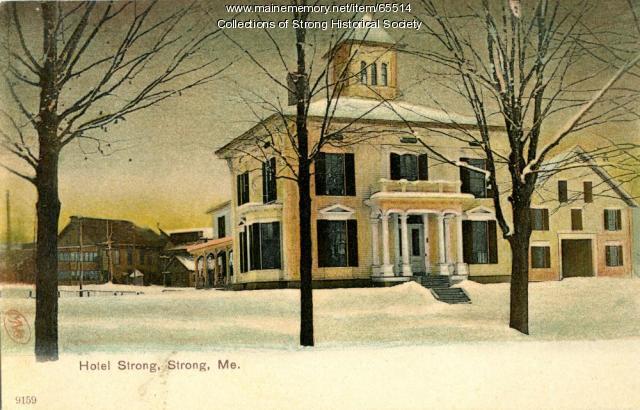Keywords: Village centers
Item 12238
Pejepscot Village General Store, Topsham, ca. 1900
Contributed by: Pejepscot History Center Date: circa 1900 Location: Topsham Media: Photograph, print
Item 13541
Brooklin Village School, ca. 1948
Contributed by: Sedgwick-Brooklin Historical Society Date: circa 1948 Location: Brooklin Media: Photo transparency
Item 151343
John B. Curtis Free Public Library, Bradford, 1913
Contributed by: Maine Historical Society Date: 1913 Location: Bradford Client: unknown Architect: John Calvin Stevens and John Howard Stevens Architects
Item 151631
Fitzgerald house, Brighton, Vermont, 1888
Contributed by: Maine Historical Society Date: 1888 Location: Brighton Client: George H. Fitzgerald Architect: John Calvin Stevens
Exhibit
Otisfield's One-Room Schoolhouses
Many of the one-room schoolhouses in Otisfield, constructed from 1839 through the early twentieth century, are featured here. The photos, most of which also show teachers and children, were taken between 1898 and 1998.
Exhibit
Maine Streets: The Postcard View
Photographers from the Eastern Illustrating and Publishing Co. of Belfast traveled throughout the state, especially in small communities, taking images for postcards. Many of these images, taken in the first three decades of the twentieth century, capture Main Streets on the brink of modernity.
Site Page
New Portland: Bridging the Past to the Future - North New Portland Village Schools
"Hopkins opened a high school at the North Village. Another source states that in 1887, a course of study way started at the North Village and John S."
Site Page
Strong, a Mussul Unsquit village - Strong's History - Page 3 of 4
"These men rode through the villages on horseback with their mailbags. Mail carriers had a pouch for each town: Strong, Kingfield, Salem…"
Story
Service in Bosnia, Iraq and Afghanistan by MAJ Adam R. Cote
by Adam R. Cote
Military Service has had a deep impact my life
Story
21st and 19th century technology and freelance photography
by Brendan Bullock
My work is a mash-up of cutting edge technology and 19th century chemistry techniques.
Lesson Plan
Grade Level: 9-12
Content Area: English Language Arts, Social Studies
Most if not all of us have or will need to work in the American marketplace for at least six decades of our lives. There's a saying that I remember a superintendent telling a group of graduating high-school seniors: remember, when you are on your deathbed, you will not be saying that you wish you had spent more time "at the office." But Americans do spend a lot more time working each year than nearly any other people on the planet. By the end of our careers, many of us will have spent more time with our co-workers than with our families.
Already in the 21st century, much has been written about the "Wal-Martization" of the American workplace, about how, despite rocketing profits, corporations such as Wal-Mart overwork and underpay their employees, how workers' wages have remained stagnant since the 1970s, while the costs of college education and health insurance have risen out of reach for many citizens. It's become a cliché to say that the gap between the "haves" and the "have nots" is widening to an alarming degree. In his book Wealth and Democracy, Kevin Phillips says we are dangerously close to becoming a plutocracy in which one dollar equals one vote.
Such clashes between employers and employees, and between our rhetoric of equality of opportunity and the reality of our working lives, are not new in America. With the onset of the industrial revolution in the first half of the nineteenth century, many workers were displaced from their traditional means of employment, as the country shifted from a farm-based, agrarian economy toward an urban, manufacturing-centered one. In cities such as New York, groups of "workingmen" (early manifestations of unions) protested, sometimes violently, unsatisfactory labor conditions. Labor unions remain a controversial political presence in America today.
Longfellow and Whitman both wrote with sympathy about the American worker, although their respective portraits are strikingly different, and worth juxtaposing. Longfellow's poem "The Village Blacksmith" is one of his most famous and beloved visions: in this poem, one blacksmith epitomizes characteristics and values which many of Longfellow's readers, then and now, revere as "American" traits. Whitman's canto (a section of a long poem) 15 from "Song of Myself," however, presents many different "identities" of the American worker, representing the entire social spectrum, from the crew of a fish smack to the president (I must add that Whitman's entire "Song of Myself" is actually 52 cantos in length).
I do not pretend to offer these single texts as all-encompassing of the respective poets' ideas about workers, but these poems offer a starting place for comparison and contrast. We know that Longfellow was the most popular American poet of the nineteenth century, just as we know that Whitman came to be one of the most controversial. Read more widely in the work of both poets and decide for yourselves which poet speaks to you more meaningfully and why.















